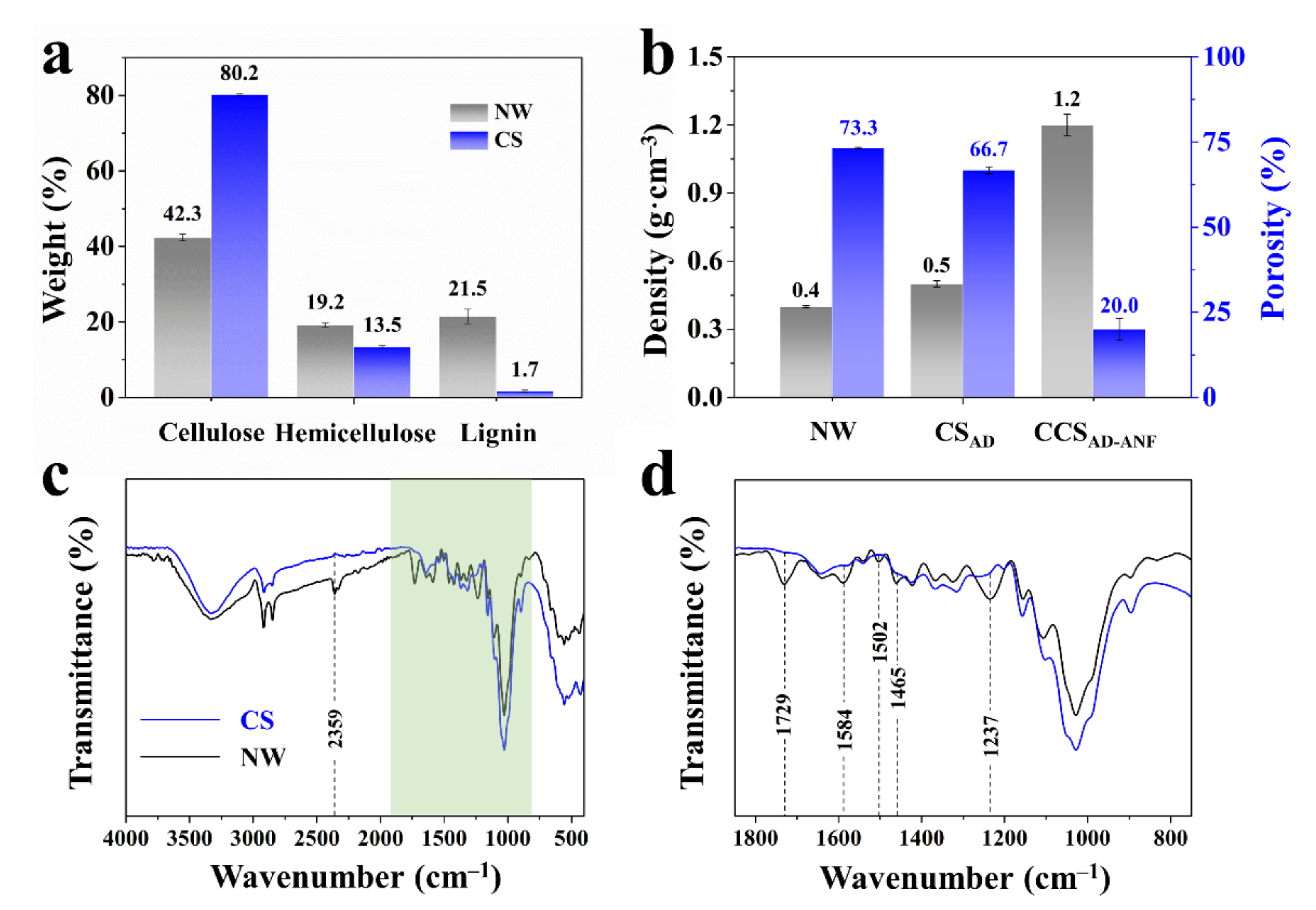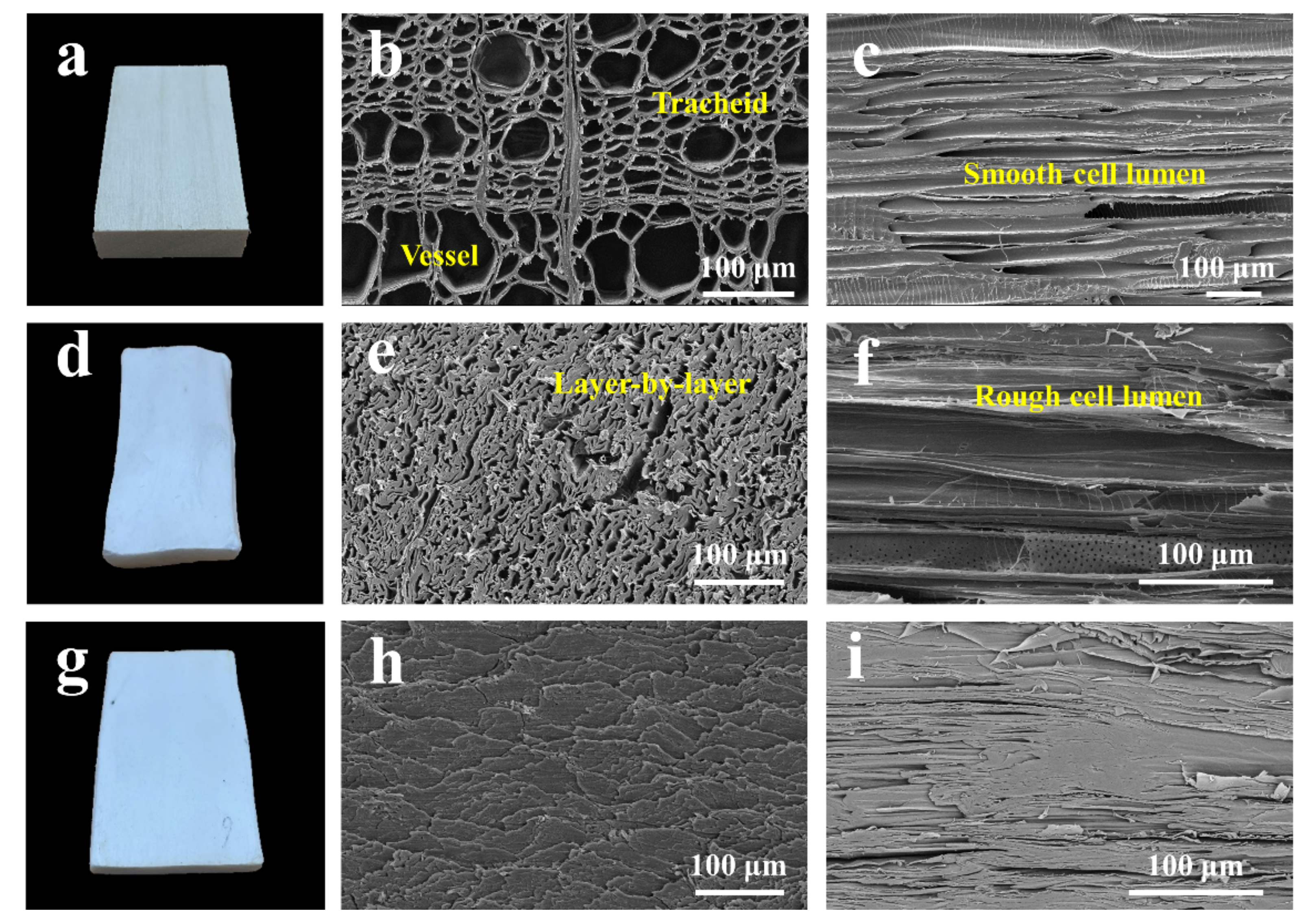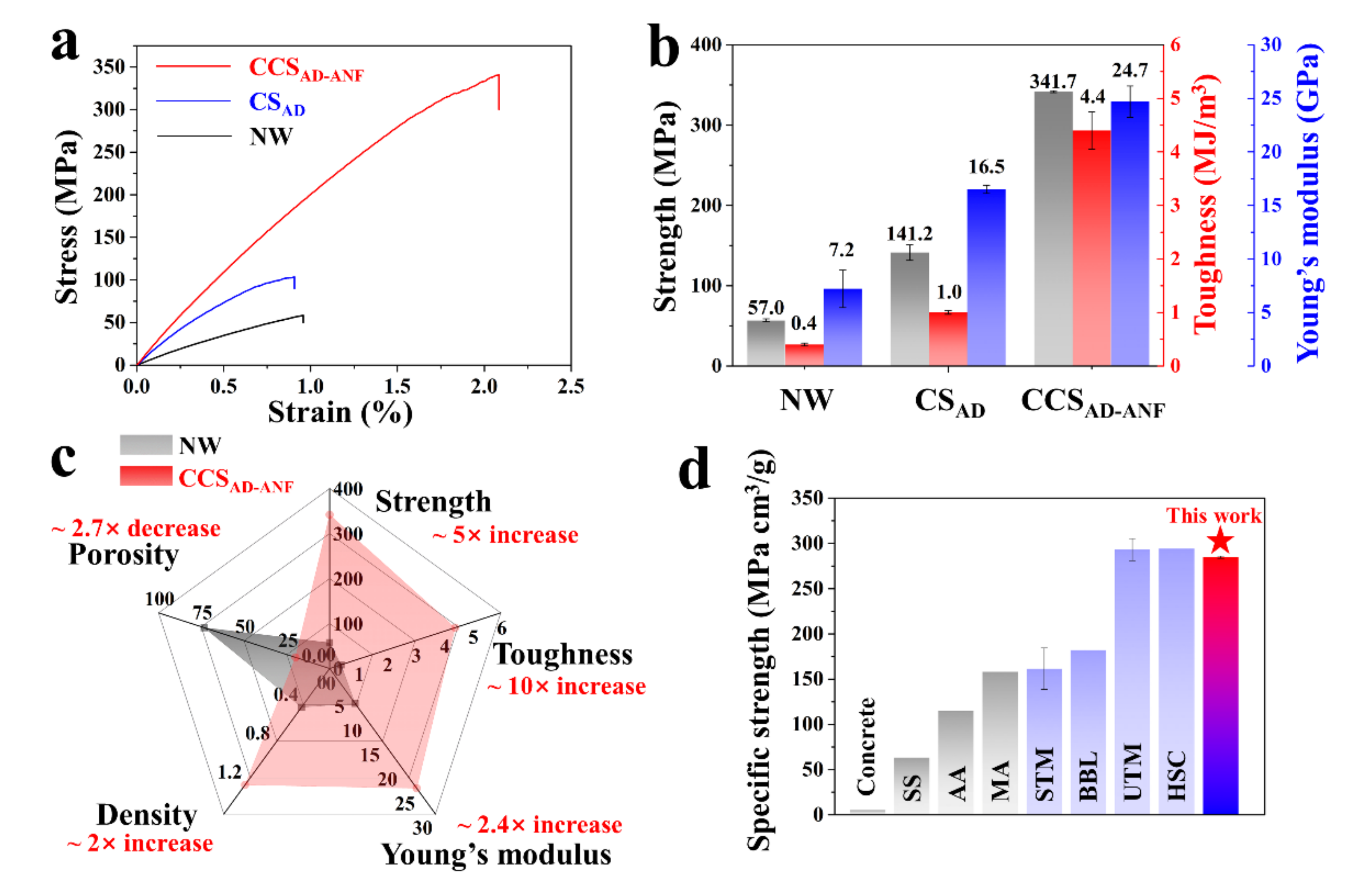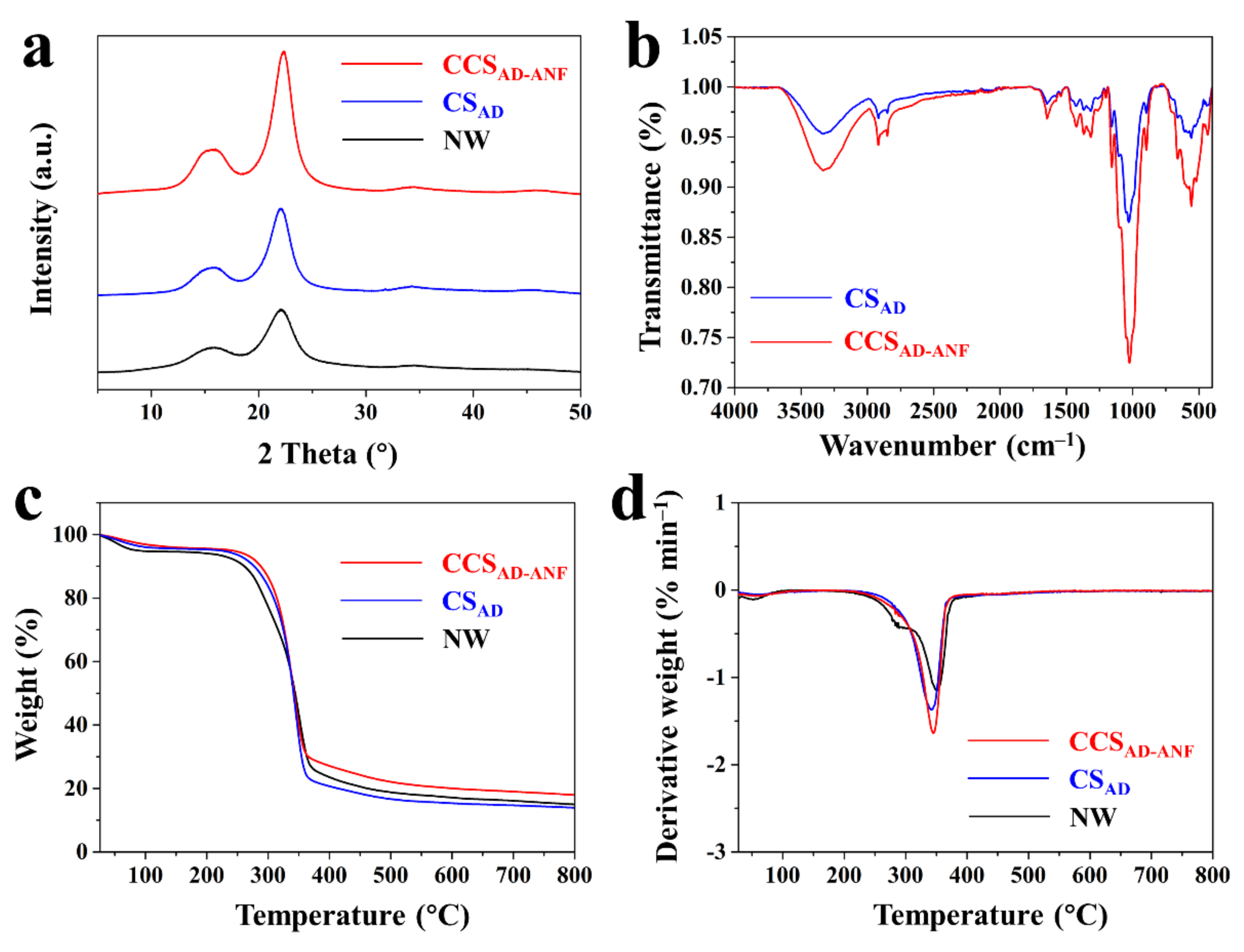Hydrogen-Bonding-Aided Fabrication of Wood Derived Cellulose Scaffold/Aramid Nanofiber into High-Performance Bulk Material
Abstract
:1. Introduction
2. Materials and Methods
2.1. Materials and Chemicals
2.2. Preparation of Aramid Nanofiber (ANF) Suspension
2.3. Fabrication of Aligned Cellulose Microfiber/ANF Hybrid Material
2.4. Chemical Component Analysis
2.5. Density and Porosity Tests
2.6. Fourier Transform Infrared (FTIR) Analysis
2.7. Scanning Electron Microscopy (SEM) Analysis
2.8. Mechanical Performance Tests
2.9. Thermogravimetric Analysis (TGA)
2.10. X-ray Diffraction (XRD) Analysis
3. Results
4. Conclusions
Supplementary Materials
Author Contributions
Funding
Institutional Review Board Statement
Informed Consent Statement
Data Availability Statement
Conflicts of Interest
References
- Song, J.W.; Chen, C.J.; Zhu, S.Z.; Zhu, M.W.; Dai, J.Q.; Ray, U.; Li, Y.J.; Kuang, Y.D.; Li, Y.F.; Quispe, N.; et al. Processing bulk natural wood into a high-performance structural material. Nature 2018, 554, 224–228. [Google Scholar] [CrossRef]
- Ding, L.; Han, X.; Jiang, S. Impregnation of poplar wood with multi-functional composite modifier and induction of in-situ polymerization by heating. J. Wood Chem. Technol. 2021, 41, 220–228. [Google Scholar] [CrossRef]
- Zhang, L.; Chen, Z.; Dong, H.; Fu, S.; Ma, L.; Yang, X. Wood plastic composites based wood wall’s structure and thermal insulation performance. J. Bioresour. Bioprod. 2021, 6, 65–74. [Google Scholar] [CrossRef]
- Huang, C.; Chui, Y.; Gong, M.; Chana, F. Mechanical behaviour of wood compressed in radial direction: Part II. Influence of temperature and moisture content. J. Bioresour. Bioprod. 2020, 5, 266–275. [Google Scholar] [CrossRef]
- Huang, C.; Gong, M.; Chui, Y.; Chan, F. Mechanical behaviour of wood compressed in radial direction-part I. New method of determining the yield stress of wood on the stress-strain curve. J. Bioresour. Bioprod. 2020, 5, 186–195. [Google Scholar] [CrossRef]
- Wang, F.; Cheong, J.Y.; Lee, J.; Ahn, J.; Duan, G.G.; Chen, H.L.; Zhang, Q.; Kim, I.D.; Jiang, S.H. Pyrolysis of Enzymolysis-Treated Wood: Hierarchically Assembled Porous Carbon Electrode for Advanced Energy Storage Devices. Adv. Funct. Mater. 2021, 31, 2101077. [Google Scholar] [CrossRef]
- Wang, C.; Yang, Z.; Wang, X.; Yu, Q. New research progress of functional wood. J. For. Eng. 2019, 4, 10–18. [Google Scholar]
- Chen, L.; Xu, Z.W.; Wang, F.; Duan, G.G.; Xu, W.H.; Zhang, G.Y.; Yang, H.Q.; Liu, J.B.; Jiang, S.H. A flame-retardant and transparent wood/polyimide composite with excellent mechanical strength. Compos. Commun. 2020, 20, 100355. [Google Scholar] [CrossRef]
- Wu, G.; Sun, J.; Huang, C.; Ren, H.; Zhao, R. Research progress on mechanical properties of tenon-mortise joints in traditional Chinese wood structures. J. For. Eng. 2020, 5, 29–37. [Google Scholar]
- Keplinger, T.; Wittel, F.K.; Ruggeberg, M.; Burgert, I. Wood Derived Cellulose Scaffolds-Processing and Mechanics. Adv. Mater. 2021, 33, 2001375. [Google Scholar] [CrossRef]
- Frey, M.; Widner, D.; Segmehl, J.S.; Casdorff, K.; Keplinger, T.; Burgert, I. Delignified and Densified Cellulose Bulk Materials with Excellent Tensile Properties for Sustainable Engineering. ACS Appl. Mater. Interfaces 2018, 10, 5030–5037. [Google Scholar] [CrossRef] [PubMed]
- Nishiyama, Y. Retrieving Structural Information from Scattering and Attenuation Data of Transparent Wood and (Nano) paper. J. Bioresour. Bioprod. 2021, 6, 187–194. [Google Scholar]
- Pan, M.; Ding, C.; Zhang, S.; Huang, Y. Progress on flame retardancy of wood plastic composites. J. For. Eng. 2020, 5, 1–12. [Google Scholar]
- Xu, F.; Chen, Y.; You, T.; Mao, J.; Zhang, X. Research progress on mechanism of cellulose dissolution. J. For. Eng. 2019, 4, 1–7. [Google Scholar]
- Zou, Y.; Yang, P.; Yang, L.; Li, N.; Duan, G.G.; Liu, X.H.; Li, Y.W. Boosting solar steam generation by photothermal enhanced polydopamine/wood composites. Polymer 2021, 217, 123464. [Google Scholar] [CrossRef]
- Tang, Q.; Zou, M.; Gao, K.; Chang, L.; Gao, L.; Guo, W. Laminating Delignified Wood Veneers toward High-Strength, Flame-Retardant Composites for Structural Applications. ACS Sustain. Chem. Eng. 2021, 9, 10717–10726. [Google Scholar] [CrossRef]
- Mi, R.Y.; Chen, C.J.; Keplinger, T.; Pei, Y.; He, S.M.; Liu, D.P.; Li, J.G.; Dai, J.Q.; Hitz, E.; Yang, B.; et al. Scalable aesthetic transparent wood for energy efficient buildings. Nat. Commun. 2020, 11, 1–9. [Google Scholar] [CrossRef]
- Li, K.; Wang, S.N.; Chen, H.; Yang, X.; Berglund, L.A.; Zhou, Q. Self-Densification of Highly Mesoporous Wood Structure into a Strong and Transparent Film. Adv. Mater. 2020, 32, 2003653. [Google Scholar] [CrossRef]
- Frey, M.; Schneider, L.; Razi, H.; Trachsel, E.; Faude, E.; Koch, S.M.; Masania, K.; Fratzl, P.; Keplinger, T.; Burgert, I. High-Performance All-Bio-Based Laminates Derived from Delignified Wood. ACS Sustain. Chem. Eng. 2021, 9, 9638–9646. [Google Scholar] [CrossRef]
- He, S.M.; Chen, C.J.; Li, T.; Song, J.W.; Zhao, X.P.; Kuang, Y.D.; Liu, Y.; Pei, Y.; Hitz, E.; Kong, W.Q.; et al. An Energy-Efficient, Wood-Derived Structural Material Enabled by Pore Structure Engineering towards Building Efficiency. Small Methods 2020, 4, 1900747. [Google Scholar] [CrossRef]
- Jakob, M.; Gaugeler, J.; Gindl-Altmutter, W. Effects of Fiber Angle on the Tensile Properties of Partially Delignified and Densified Wood. Materials 2020, 13, 5405. [Google Scholar] [CrossRef]
- Jiang, S.; Zhou, M.; Deng, W.; Dai, H.; Fang, G.; Wu, W. High-wet-strength paper-based lignocellulosic adsorbents and its heavy metal ion adsorption properties. J. For. Eng. 2020, 5, 101–107. [Google Scholar]
- Joseph, B.; Sagarika, V.; Sabu, C.; Kalarikkal, N.; Thomas, S. Cellulose nanocomposites: Fabrication and biomedical applications. J. Bioresour. Bioprod. 2020, 5, 223–237. [Google Scholar] [CrossRef]
- Yano, H.; Hirose, A.; Collins, P.J.; Yazaki, Y. Effects of the removal of matrix substances as a pretreatment in the production of high strength resin impregnated wood based materials. J. Mater. Sci. Lett. 2001, 20, 1125–1126. [Google Scholar] [CrossRef]
- Han, X.S.; Ye, Y.H.; Lam, F.; Pu, J.W.; Jiang, F. Hydrogen-bonding-induced assembly of aligned cellulose nanofibers into ultrastrong and tough bulk materials. J. Mater. Chem. A 2019, 7, 27023–27031. [Google Scholar] [CrossRef]
- Zou, Y.; Zhao, J.Y.; Zhu, J.Y.; Guo, X.Y.; Chen, P.; Duan, G.G.; Liu, X.H.; Li, Y.W. A Mussel-Inspired Polydopamine-Filled Cellulose Aerogel for Solar-Enabled Water Remediation. ACS Appl. Mater. Interfaces 2021, 13, 7617–7624. [Google Scholar] [CrossRef] [PubMed]
- Chen, Y.M.; Zhang, L.; Mei, C.T.; Li, Y.; Duan, G.G.; Agarwal, S.; Greiner, A.; Ma, C.X.; Jiang, S.H. Wood-Inspired Anisotropic Cellulose Nanofibril Composite Sponges for Multifunctional Applications. ACS Appl. Mater. Interfaces 2020, 12, 35513–35522. [Google Scholar] [CrossRef]
- Xie, C.J.; Guo, Z.X.; Qiu, T.; Tuo, X.L. Construction of Aramid Engineering Materials via Polymerization-Induced para-Aramid Nanofiber Hydrogel. Adv. Mater. 2021, 33, e2101280. [Google Scholar] [CrossRef]
- Guo, H.; Li, Y.; Ji, Y.; Chen, Y.; Liu, K.; Shen, B.; He, S.; Duan, G.; Han, J.; Jiang, S.J.C.C. Highly flexible carbon nanotubes/aramid nanofibers composite papers with ordered and layered structures for efficient electromagnetic interference shielding. Compos. Commun. 2021, 27, 100879. [Google Scholar] [CrossRef]
- Yang, B.; Wang, L.; Zhang, M.Y.; Lu, Z.Q.; Tan, J.J.; Luo, J.L.; Lu, P. Water-resistant, transparent, uvioresistant cellulose nanofiber (CNF)-aramid nanofiber (ANF) hybrid nanopaper. Mater. Lett. 2019, 240, 165–168. [Google Scholar] [CrossRef]
- Yang, B.; Zhang, M.Y.; Lu, Z.Q.; Tan, J.J.; Luo, J.J.; Song, S.X.; Ding, X.Y.; Wang, L.; Lu, P.; Zhang, Q.Y. Comparative study of aramid nanofiber (ANF) and cellulose nanofiber (CNF). Carbohydr. Polym. 2019, 208, 372–381. [Google Scholar] [CrossRef] [PubMed]
- Yang, M.; Cao, K.Q.; Sui, L.; Qi, Y.; Zhu, J.; Waas, A.; Arruda, E.M.; Kieffer, J.; Thouless, M.D.; Kotov, N.A. Dispersions of Aramid Nanofibers: A New Nanoscale Building Block. ACS Nano 2011, 5, 6945–6954. [Google Scholar] [CrossRef] [PubMed] [Green Version]
- Lyu, J.; Wang, X.Z.; Liu, L.H.; Kim, Y.; Tanyi, E.K.; Chi, H.; Feng, W.C.; Xu, L.Z.; Li, T.H.; Noginov, M.A.; et al. High Strength Conductive Composites with Plasmonic Nanoparticles Aligned on Aramid Nanofibers. Adv. Funct. Mater. 2016, 26, 8435–8445. [Google Scholar] [CrossRef]
- Zhu, J.; Yang, M.; Emre, A.; Bahng, J.H.; Xu, L.Z.; Yeom, J.; Yeom, B.; Kim, Y.; Johnson, K.; Green, P.; et al. Branched Aramid Nanofibers. Angew. Chem. -Int. Ed. 2017, 56, 11744–11748. [Google Scholar] [CrossRef]
- Tung, S.O.; Ho, S.; Yang, M.; Zhang, R.L.; Kotov, N.A. A dendrite-suppressing composite ion conductor from aramid nanofibres. Nat. Commun. 2015, 6, 6152. [Google Scholar] [CrossRef]
- Jung, J.; Sodano, H.A. High strength epoxy nanocomposites reinforced by epoxy functionalized aramid nanofibers. Polymer 2020, 195, 122438. [Google Scholar] [CrossRef]
- Li, J.Y.; Lu, Z.Q.; Xie, F.; Huang, J.Z.; Ning, D.D.; Zhang, M.Y. Highly compressible, heat-insulating and self-extinguishing cellulose nanofiber/aramid nanofiber nanocomposite foams. Carbohydr. Polym. 2021, 261, 117837. [Google Scholar] [CrossRef]
- Yang, B.; Wang, L.; Zhang, M.Y.; Li, W.W.; Zhou, Q.K.; Zhong, L.X. Advanced separators based on aramid nanofiber (ANF) membranes for lithium-ion batteries: A review of recent progress. J. Mater. Chem. A 2021, 9, 12923–12946. [Google Scholar] [CrossRef]
- Zhou, Y.; Wang, S.J.; Li, D.S.; Jiang, L. Lightweight and recoverable ANF/rGO/PI composite aerogels for broad and high-performance microwave absorption. Compos. Part B-Eng. 2021, 213, 108701. [Google Scholar] [CrossRef]
- Han, X.; Wang, Z.; Ding, L.; Chen, L.; Wang, F.; Pu, J.; Jiang, S. Water molecule-induced hydrogen bonding between cellulose nanofibers toward highly strong and tough materials from wood aerogel. Chin. Chem. Lett. 2021, in press. [Google Scholar] [CrossRef]
- Sluiter, A.; Hames, B.; Ruiz, R.; SCarlata, C.; Sluiter, J.; TempletOn, D.; Crocker, D. Determination of structural carbohydrates and lignin in biomass. Lab. Anal. Proced. 2008, 1617, 1–16. [Google Scholar]
- Yang, X.; Berthold, F.; Berglund, L.A. High-Density Molded Cellulose Fibers and Transparent Biocomposites Based on Oriented Holocellulose. ACS Appl. Mater. Interfaces 2019, 11, 10310–10319. [Google Scholar] [CrossRef] [PubMed] [Green Version]
- Hervy, M.; Santmarti, A.; Lahtinen, P.; Tammelin, T.; Lee, K.Y. Sample geometry dependency on the measured tensile properties of cellulose nanopapers. Mater. Des. 2017, 121, 421–429. [Google Scholar] [CrossRef]
- Segal, L.; Creely, J.J.; Martin, A., Jr.; Conrad, C. An empirical method for estimating the degree of crystallinity of native cellulose using the X-ray diffractometer. Text. Res. J. 1959, 29, 786–794. [Google Scholar] [CrossRef]
- Lu, Z.Q.; Si, L.M.; Dang, W.B.; Zhao, Y.S. Transparent and mechanically robust poly (para-phenylene terephthamide) PPTA nanopaper toward electrical insulation based on nanoscale fibrillated aramid-fibers. Compos. Part A-Appl. Sci. Manuf. 2018, 115, 321–330. [Google Scholar] [CrossRef]
- Si, L.M.; Lu, Z.Q.; Yao, C.; Ma, Q.; Zhao, Y.S.; Wang, Y.F.; Wang, D.N.; Jin, Z.F. Nacre-like nanocomposite film with excellent dielectric insulation properties and mechanical strength based on montmorillonite nanosheet and aramid nanofiber. J. Mater. Sci. 2020, 55, 5948–5960. [Google Scholar] [CrossRef]
- Zong, P.J.; Jiang, Y.; Tian, Y.Y.; Li, J.; Yuan, M.; Ji, Y.Y.; Chen, M.S.; Li, D.W.; Qiao, Y.Y. Pyrolysis behavior and product distributions of biomass six group components: Starch, cellulose, hemicellulose, lignin, protein and oil. Energy Convers. Manag. 2020, 216, 112777. [Google Scholar] [CrossRef]
- Lu, Y.X.; Tao, P.; Zhang, N.; Nie, S.X. Preparation and thermal stability evaluation of cellulose nanofibrils from bagasse pulp with differing hemicelluloses contents. Carbohydr. Polym. 2020, 245, 116463. [Google Scholar] [CrossRef] [PubMed]
- Yang, B.; Wang, L.; Zhang, M.Y.; Luo, J.J.; Lu, Z.Q.; Ding, X.Y. Fabrication, Applications, and Prospects of Aramid Nanofiber. Adv. Funct. Mater. 2020, 30, 2000186. [Google Scholar] [CrossRef]
- Patterson, B.A.; Malakooti, M.H.; Lin, J.J.; Okorom, A.; Sodano, H.A. Aramid nanofibers for multiscale fiber reinforcement of polymer composites. Compos. Sci. Technol. 2018, 161, 92–99. [Google Scholar] [CrossRef]





Publisher’s Note: MDPI stays neutral with regard to jurisdictional claims in published maps and institutional affiliations. |
© 2021 by the authors. Licensee MDPI, Basel, Switzerland. This article is an open access article distributed under the terms and conditions of the Creative Commons Attribution (CC BY) license (https://creativecommons.org/licenses/by/4.0/).
Share and Cite
Han, X.; Wu, W.; Wang, J.; Tian, Z.; Jiang, S. Hydrogen-Bonding-Aided Fabrication of Wood Derived Cellulose Scaffold/Aramid Nanofiber into High-Performance Bulk Material. Materials 2021, 14, 5444. https://doi.org/10.3390/ma14185444
Han X, Wu W, Wang J, Tian Z, Jiang S. Hydrogen-Bonding-Aided Fabrication of Wood Derived Cellulose Scaffold/Aramid Nanofiber into High-Performance Bulk Material. Materials. 2021; 14(18):5444. https://doi.org/10.3390/ma14185444
Chicago/Turabian StyleHan, Xiaoshuai, Weijie Wu, Jingwen Wang, Zhiwei Tian, and Shaohua Jiang. 2021. "Hydrogen-Bonding-Aided Fabrication of Wood Derived Cellulose Scaffold/Aramid Nanofiber into High-Performance Bulk Material" Materials 14, no. 18: 5444. https://doi.org/10.3390/ma14185444
APA StyleHan, X., Wu, W., Wang, J., Tian, Z., & Jiang, S. (2021). Hydrogen-Bonding-Aided Fabrication of Wood Derived Cellulose Scaffold/Aramid Nanofiber into High-Performance Bulk Material. Materials, 14(18), 5444. https://doi.org/10.3390/ma14185444






